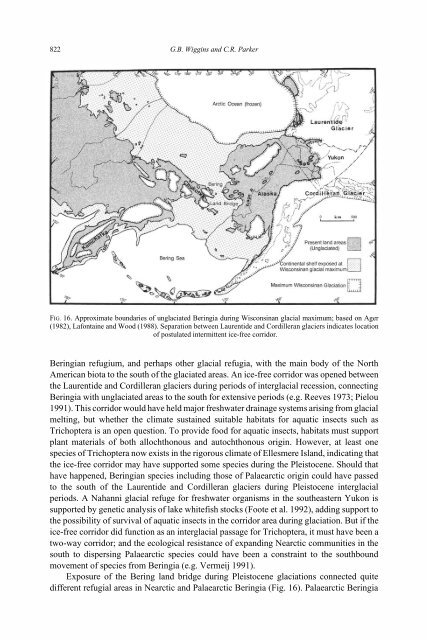Caddisflies of the Yukon - Department of Biological Sciences ...
Caddisflies of the Yukon - Department of Biological Sciences ...
Caddisflies of the Yukon - Department of Biological Sciences ...
You also want an ePaper? Increase the reach of your titles
YUMPU automatically turns print PDFs into web optimized ePapers that Google loves.
822 G.B. Wiggins and C.R. Parker<br />
FIG. 16. Approximate boundaries <strong>of</strong> unglaciated Beringia during Wisconsinan glacial maximum; based on Ager<br />
(1982), Lafontaine and Wood (1988). Separation between Laurentide and Cordilleran glaciers indicates location<br />
<strong>of</strong> postulated intermittent ice-free corridor.<br />
Beringian refugium, and perhaps o<strong>the</strong>r glacial refugia, with <strong>the</strong> main body <strong>of</strong> <strong>the</strong> North<br />
American biota to <strong>the</strong> south <strong>of</strong> <strong>the</strong> glaciated areas. An ice-free corridor was opened between<br />
<strong>the</strong> Laurentide and Cordilleran glaciers during periods <strong>of</strong> interglacial recession, connecting<br />
Beringia with unglaciated areas to <strong>the</strong> south for extensive periods (e.g. Reeves 1973; Pielou<br />
1991). This corridor would have held major freshwater drainage systems arising from glacial<br />
melting, but whe<strong>the</strong>r <strong>the</strong> climate sustained suitable habitats for aquatic insects such as<br />
Trichoptera is an open question. To provide food for aquatic insects, habitats must support<br />
plant materials <strong>of</strong> both allochthonous and autochthonous origin. However, at least one<br />
species <strong>of</strong> Trichoptera now exists in <strong>the</strong> rigorous climate <strong>of</strong> Ellesmere Island, indicating that<br />
<strong>the</strong> ice-free corridor may have supported some species during <strong>the</strong> Pleistocene. Should that<br />
have happened, Beringian species including those <strong>of</strong> Palaearctic origin could have passed<br />
to <strong>the</strong> south <strong>of</strong> <strong>the</strong> Laurentide and Cordilleran glaciers during Pleistocene interglacial<br />
periods. A Nahanni glacial refuge for freshwater organisms in <strong>the</strong> sou<strong>the</strong>astern <strong>Yukon</strong> is<br />
supported by genetic analysis <strong>of</strong> lake whitefish stocks (Foote et al. 1992), adding support to<br />
<strong>the</strong> possibility <strong>of</strong> survival <strong>of</strong> aquatic insects in <strong>the</strong> corridor area during glaciation. But if <strong>the</strong><br />
ice-free corridor did function as an interglacial passage for Trichoptera, it must have been a<br />
two-way corridor; and <strong>the</strong> ecological resistance <strong>of</strong> expanding Nearctic communities in <strong>the</strong><br />
south to dispersing Palaearctic species could have been a constraint to <strong>the</strong> southbound<br />
movement <strong>of</strong> species from Beringia (e.g. Vermeij 1991).<br />
Exposure <strong>of</strong> <strong>the</strong> Bering land bridge during Pleistocene glaciations connected quite<br />
different refugial areas in Nearctic and Palaearctic Beringia (Fig. 16). Palaearctic Beringia
















